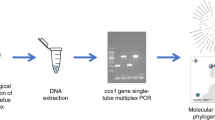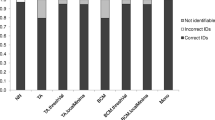Abstract
The outbreak of bluetongue disease in Central Europe necessitates new approaches in the identification of vectors to follow-up changes of populations of species and not of complexes. Since females of species of the complex of Culicoides obsoletus are difficult to be identified according to morphological criteria, we applied a polymerase chain reaction (PCR)-based strategy targeting the mitochondrial cytochrome oxidase subunit I to differentiate between the species Culicoides obsoletus s.s. and Culicoides scoticus. Catches of culicoids obtained from May to November 2007 in an ultraviolet lamp trap at a cattle farm in Rhineland-Palatinate, Southern Germany were surveyed for changes of the abundance of both species. Only in May 2007, the samples contained similar proportions of both species. Afterwards, C. scoticus dominated with up to 88%. Calculating the number of specimens of both species within the total catches of culicoids, the numbers of C. obsoletus s.s. slightly decreased from May to July and increased to a little maximum in August. C. scoticus seemed to have three maxima in this period of time, the strongest one in August, presumably due to different generations and not to climatic conditions. These results indicate that the applied PCR strategy can be used for a detailed analysis of culicoids as basis for the estimation of the transmission risk of the bluetongue virus by different species of the Obsoletus complex.




Similar content being viewed by others
References
Baldet T, Delécolle JC, Mathieu B, de la Rocque S, Roger F (2004) Entomological surveillance of bluetongue in France 2002. Vet Ital 40:226–231
Boorman J (1993) Biting midges (Ceratopogonidae). In: Lane RP, Crosskey RW (eds) Medical insects and arachnids. Chapman & Hall, London, pp 289–309
Boorman JPT, Hagan DV (2007) A name list of world Culicoides (Diptera: Ceratopogonidae) [http://campus.belmont.edu/cienews/culicoides_worldlist.html]
Borkent A (2007) World list of biting midges (Diptera: Ceratopogonidae) [http://www.inhs.uiuc.edu/research/FLYTREE/CeratopogonidaeCatalog.pdf]
Campbell JA, Pelham-Clinton EC (1960) A taxonomic review of the British species of Culicoides Latreille (Diptera: Ceratopogonidae). Proc R Soc Edinburgh (B) 67:181–302
Cêtre-Sossah C, Baldet T, Delécolle JC, Mathieu B, Perrin A, Grillet C, Albina E (2004) Molecular detection of Culicoides spp. and Culicoides imicola, the principal vector of bluetongue (BT) and African horse sickness (AHS) in Africa and Europe. Vet Res 35:325–337
Conte A, Goffredo M, Ippoliti C, Meiswinkel R (2007) Influence of biotic and abiotic factors on the distribution and abundance of Culicoides imicola and the Obsoletus Complex in Italy. Vet Parasitol 150:333–344
Fenner F (1976) The classification and nomenclature of viruses. Summary of results of meetings of the International Committee on Taxonomy of Viruses in Madrid, September 1975. J Gen Virol 31:463–470
Gibbs EP, Greiner EC (1994) The epidemiology of bluetongue. Comp Immunol Microbiol Infect Dis 17:207–220
Gloor GB, Preston CR, Johnson-Schlitz DM, Nassif NA, Phillis RW, Benz WK, Robertson HM, Engels WR (1993) Type I repressors of P element mobility. Genetics 135:81–95
Goffredo M, Meiswinkel R (2004) Entomological surveillance of bluetongue in Italy: methods of capture, catch analysis and identification of Culicoides biting midges. Vet Ital 40:260–265
Goltz J (1978) Bluetongue in cattle: a review. Can Vet J 19:95–98
Gomulski LM, Meiswinkel R, Delécolle JC, Goffredo M, Gasperi G (2005) Phylogenetic relationships of the subgenus Avaritia Fox, 1955 including Culicoides obsoletus (Diptera, Ceratopogonidae) in Italy based on internal transcribed spacer 2 ribosomal DNA sequences. System Entomol 30:619–631
Gomulski LM, Meiswinkel R, Delécolle JC, Goffredo M, Gasperi G (2006) Phylogeny of the subgenus Culicoides and related species in Italy, inferred from internal transcribed spacer 2 ribosomal DNA sequences. Med Vet Entomol 20:229–238
Liebisch A, Liebisch G (2007) Biologie und Bekämpfung von Culicoides-Mücken als Vektor der Bluetongue bei Rindern in Deutschland. Prak Tierarzt 88:440–449
Maan S, Maan NS, Singh KP, Samuel AR, Mertens PPC (2004) Development of reverse transcriptase-polymerase chain reaction-based assay and sequencing for typing European strains of bluetongue virus and differential diagnosis of field and vaccine strains. Vet Ital 40:552–561
Mas-Coma S, Bargues MD (2008) Populations, hybrids and the systematic concepts of species and subspecies in Chagas disease triatomine vectors inferred from nuclear ribosomal and mitochondrial DNA. Acta Trop doi:10.1016/j.actatropica.2008.10.013
Mathieu B, Perrin A, Baldet T, Delécolle JC, Albina E, Cêtre-Sossah C (2007) Molecular identification of Western European species of obsoletus complex (Diptera: Ceratopogonidae) by an internal transcribed spacer-1 rDNA multiplex polymerase chain reaction assay. J Med Entomol 44:1019–1025
Mehlhorn H, Walldorf V, Klimpel S, Jahn B, Jaeger F, Eschweiler J, Hoffmann B, Beer M (2007) First occurrence of Culicoides obsoletus-transmitted Bluetongue virus epidemic in Central Europe. Parasitol Res 101:219–228
Mehlhorn H, Walldorf V, Klimpel S, Schaub GA, Kiel E, Liebisch G, Liebisch A, Werner D, Bauer C, Clausen H, Bauer B, Geier M, Hörbrand, Bätza H-J, Conraths FJ, Hoffmann B, Beer M (2009) Bluetongue Disease in Germany (2007–2008): Monitoring of Entomological Aspects. Parasitol Res (in press) doi:10.1007/s00436-009-1416-y
Meiswinkel R, Gomulski LM, Delécolle JC, Goffredo M, Gasperi G (2004) The taxonomy of Culicoides vector complexes–unfinished business. Vet Ital 40:151–159
Nolan DV, Carpenter S, Barber J, Mellor PS, Dallas JF, Mordue Luntz AJ, Piertney SB (2007) Rapid diagnostic PCR assays for members of the Culicoides obsoletus and Culicoides pulicaris species complexes, implicated vectors of bluetongue virus in Europe. Vet Microbiol 124:82–94
Pages N, Sarto i Monteys V (2005) Differentiation of Culicoides obsoletus and Culicoides scoticus (Diptera: Ceratopogonidae) based on mitochondrial cytochrome oxidase subunit I. J Med Entomol 42:1026–1034
Parsonson IM (1990) Pathology and pathogenesis of bluetongue infections. Curr Top Microbiol Immunol 162:119–141
Perrin A, Cêtre-Sossah C, Mathieu B, Baldet T, Delécolle JC, Albina E (2006) Phylogenetic analysis of Culicoides species from France based on nuclear ITS1-rDNA sequences. Med Vet Entomol 20:219–228
Rawlings P (1996) A key, based on wing patterns of biting midges (genus Culicoides Latreille-Diptera: Ceratopogonidae) in the Iberian Peninsula, for use in epidemiological studies. Graellsia 52:57–71
Schwartz-Cornil I, Mertens PP, Contreras V, Hemati B, Pascale F, Breard E, Mellor PS, MacLachlan NJ, Zientara S (2008) Bluetongue virus: virology, pathogenesis and immunity. Vet Res 39:46
Schwenkenbecher JM, Mordue Luntz AJ, Piertney SB (2008) Phylogenetic analysis indicates that Culicoides dewulfi should not be considered part of the Culicoides obsoletus complex. Bull Entomol Res 9:1–5
Simon C, Frati F, Beckenbach A, Crespi B, Liu H, Flook P (1994) Evolution, weighting, and phylogenetic utility of mitochondrial gene-sequences and a compilation of conserved polymerase chain-reaction primers. Ann Entomol Soc Am 87:651–701
Verwoerd DW (1969) Purification and characterization of bluetongue virus. Virology 38:203–212
Verwoerd DW, Louw H, Oellermann RA (1970) Characterization of bluetongue virus ribonucleic acid. J Virol 5:1–7
Vorsprach B, Meiser CK, Werner D, Balczun C, Schaub GA (2009) Monitoring of Ceratopogonidae in Southwest Germany. Parasitol Res (in press) doi:10.1007/s00436-009-1411-3
Wirth WW, Hubert AA (1989) The Culicoides of Southeast Asia (Diptera: Ceratopogonidae). Mem Am Entomol Inst 44:1–508
Acknowledgements
We very much appreciate the funding of the collection of the midges by the German Federal Ministry of Food, Agriculture and User Protection (BMLEV), especially the organization by Dr. H.-J. Bätza.
Author information
Authors and Affiliations
Corresponding author
Additional information
Carsten Balczun and Bettina Vorsprach contributed equally to this study
Rights and permissions
About this article
Cite this article
Balczun, C., Vorsprach, B., Meiser, C.K. et al. Changes of the abundance of Culicoides obsoletus s.s. and Culicoides scoticus in Southwest Germany identified by a PCR-based differentiation. Parasitol Res 105, 345–349 (2009). https://doi.org/10.1007/s00436-009-1412-2
Received:
Accepted:
Published:
Issue Date:
DOI: https://doi.org/10.1007/s00436-009-1412-2




